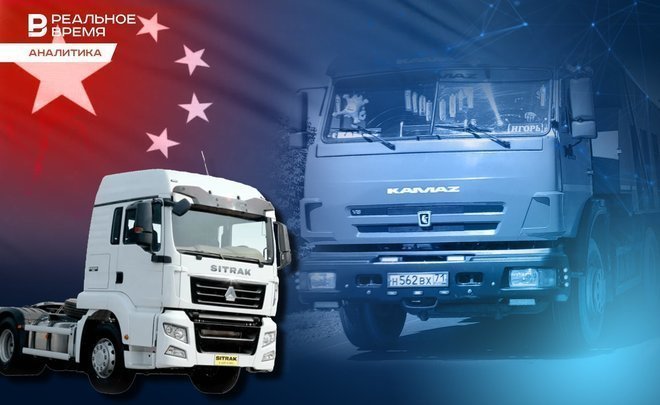Chinese outrun KAMAZ: overview of Russian market of new lorries
Chinese lorry manufacturers have occupied more than half of the Russian car market

More than 53% of the new lorry market in Russia is occupied by Chinese manufacturers, and the most popular model is SITRAK C7H — a quite decent and cheaper copy of the German MAN. The European “seven” voluntarily ceded Russia to manufacturers from China, and domestic manufacturers are focused mainly on state defense orders. The current situation may lead to that Russian trucks will become “niche” products exclusively for state needs, and the Chinese will seize the entire private market. About the development forecasts of the market of new lorries, the most popular models and sales of KAMAZ — in the review of the analytical service of Realnoe Vremya.
Chinese Tsunami
Sanctions and interruptions in the supply of components are transforming the Russian market of new lorries. KAMAZ still retains the status of the No. 1 brand and the sales leader in Russia (as well as Lada), but the share of the Naberezhnye Chelny auto giant is declining. In January 2023, 1,765 KAMAZ lorries were sold, or by 24,2% less than in the same period last year.
Chinese manufacturers are “breathing” into the back of KAMAZ: SITRAK, SHACMAN, FAW and HOWO, whose combined sales in January exceeded 3 thousand vehicles. Russian GAS is the sixth by popularity, but its sales also fell by 32,5% in January — to 414 cars. Another Russian manufacturer, Ural, collapsed by 66,8% to 178 lorries. While Chinese manufacturers showed record sales rates. Belarusian MAZ felt a little better than the Russians, having increased sales by 70,4% to 409 cars, but it was also affected by the wave of anti-Russian sanctions.
In February 2023, the trend of reducing the share of Russian manufacturers continued: sales of KAMAZ fell by 37,9% compared to last year — to 2,020 vehicles. But SITRAK sold 485 more lorries than in January 2023 and retained the second position in the rating of popular brands of new lorries. The sales of SHACMAN, FAW, HOWO and FOTON have increased.
Only the Chinese JAC began to lose ground. Here another trend has manifested itself, characteristic of the Russian car market in 2023 — the Chinese are competing here not only with Russians and Belarusian MAZ, but also very actively with each other. And JAC doesn't seem to stand up to this competition anymore. Its sales fell by 14,1% compared to the same period last year.
The most popular model on the new lorry market in January was the Chinese SITRAK C7H. The second is also the Chinese FAW CA3310. KAMAZ 43118 and KAMAZ 65115 are the third and fourth, respectively.
At the same time, the sales of KAMAZ 43118 fell by 18,9%, and the Russian model GAZ GAZON NEXT — by 34,3%. For comparison, the sales of Chinese FAW CA3310 increased from 31 trucks in January 2022 to 471 vehicles in January 2023. SHACMAN SX3318, SHACMAN SX3258, and HOWO T5G are actively conquering the Russian market.
The top models of the sales leaders in February 2023 have not changed — these are SITRAK C7H, FAW CA3310, and KAMAZ 43118. But the sales of KAMAZ 43118, according to Autostat, continue to decline — in February by 32,5%. GAS also continued to lose ground — by 32,8%.
Predictably, Russian manufacturers also lost market share of new trucks in the first 2 months of 2023. Thus, the share of KAMAZ fell from 38% to 24,5%, GAZ reduced its share from 9% to 6%, and Ural — from 7,8 to 3%. SITRAK immediately took 16% of the market, SHACMAN — 13,9%, FAW — 9%.
The SITRAK C7H model took 16% of the market, FAW CA3310 — 6,7%, KAMAZ 43118 — 6,6%.
KAMAZ still holds the leadership in the market of new trucks, ahead of Chinese manufacturers.
The best-selling models on the Russian market in the first months of 2023 were the Chinese SITRAK C7H and FAW CA3310.
Picture is incomplete: Autostat did not take into account the state defense order
“The studies of the Russian market of Autostat are based on registrations of vehicles in the traffic police, that is, only on open and accessible sources. At the same time, trucks that KAMAZ and other Russian manufacturers supply under the state defense order (this information is state secret) are not registered in the traffic police, and therefore do not get into statistics, and to new territories where the vehicle accounting system has not yet been tuned up," Oleg Afanasyev, the director of the Public Relations Department of KAMAZ JSC, commented on the figures.

Oleg Afanasyev did not mention the figures of the real state of affairs in the Russian heavy lorry market, hinting that Russian manufacturers, on the contrary, are increasing production this year. “For example, we work overtime and on weekends," he cited as an example.
Chinese lorries today are filling the niche of European (and other unfriendly) manufacturers, who, one might say, voluntarily have given it to them, Afanasyev explains. At the same time, the Russian heavy truck market is the first in Europe and the fifth in the world in terms of volumes. Foreigners have always occupied from 30% to 45% of it. “Chinese trucks are as serious competitors for us as European ones," he admitted. “But they have the same problems as European manufacturers — a weak service network, which is a key point in our reality.”
Autostat refrained from commenting on the sales of new lorries in Russia. The expert of Autostat Info, Alexander Klimnov, confirmed that sales of KAMAZ, Ural, and GAS fell only formally: “KAMAZ operates 24 hours a day for two 12-hour shifts (the rest, I think, too), so they actually produce more trucks than they show in statistics. In fact, for example, in the statistics of Autostat-Info, cars are also indicated by registration.”
European “seven” has lost Russia
The SITRAK C7H model is technically quite a decent copy of MAN, which is exactly what unassuming Russian carriers need, Alexander Klimnov believes.

Parallel import of European lorries hasn’t yet been set up. And this is also the cause of the “Chinese tsunami” — there is simply no alternative. While Russian car factories depend on public contracts and a deficit.
According to the National Agency of Industrial Information, Chinese companies already occupied a four-fifth part of the segment of forklifts, nearly two-thirds of the market of new tractor units and the share of Chinese brands in the market of new construction machinery (front-end loader, bulldozers and concrete mixers) reached 58% in January-February 2023. Chinese also hold almost a third of the market of new lift trucks. In January-February, according to the agency, Chinese manufacturers account for 53,4% of the market of new lorries. Avtostat Info says about 53.7%.
The given situation can lead to a situation in which Russian commercial machinery producers except for LCV will become niche to be purchased by security and other public agencies, while the private market will be provided by manufacturers from the Celestial Kingdom. “It is not the time to impose protectionist barriers against our ‘key friend,’” Alexander Klimnov is convinced.
Competition in the lorry market will just grow

Dmitry Baranov doesn’t think the rise in sales of lorries from the PRC a long-term tendency. “Russian manufacturers can cement their position when the situation returns to normalcy and will sell more products,” he forecasts.
Also, if the state provides support to Russian producers and consumers, Russian lorry sales can go up. “It can be various measures to stimulate the demand for lorries, concessions for production, guarantees, purchase of lorries for the state’s needs, big projects,” he enumerates. “At the same time, there can be changes in the lorry market: Chinese brands will occupy the seats of some brands that temporarily left the country. However, thanks to parallel import, lorries of those brands will start supplying products to the country, so that competition in the Russian market in general will increase.”